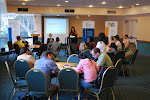 |
| Image of grinning man in Aloha shirt pointing to data chart while volcano explodes in the background. |
I was recently asked to write a forward to a book about the portrayal of disability in literature. When I asked what the author would like me to highlight, he suggested something about progress that has been made and progress that has yet to come about attitudes towards people with disabilities. Progress. We are always striving forward towards progress, measuring our progress and the progress we have yet to achieve. Always talking about the way it used to be and always hoping for something better for the future.
 |
| Image of empty bed in State Hospital labeled "The Lives They Left Behind Suitcases from a State Hospital Attic" |
In a recent class discussion for my Introduction to Disability and Diversity course, we talked about the institutionalization of people with disabilities. The students had been asked to view a video called "When the Moon Comes Up" by Norman Kunc, who talks about how his parents made the choice to raise him at home rather than have him institutionalized as the doctors suggested. The film shows Kunc with his wife and children, on the job, sailing his sailboat, and then transitions to photos from the 1960s of inmates at a residential institution for people with developmental disabilities accompanied by a haunting lyric, "When the moon comes up, it shines on them too, cut them and they bleed..." The film ends with Kunc saying, "It is sobering to realize how much the course of a life can be altered by a single decision."
"That was a really powerful video we watched," commented one of my students, "I'm so glad we don't have institutions like that anymore. It's so good that people with disabilities can now receive services instead of being stuck in a place like that." And so I had to explain that no indeed, there were still institutions where people with disabilities were stuck. Maybe, at least in the United States, they are not quite like they used to be. You don't see images of naked starving people covered in feces wandering the halls like the images that we saw in the film, but there are still people who could easily tell you how other people's misperceptions and power has adversely affected their lives. Can we pat ourselves for making progress in this area? Not really.
 |
| Photo of protesters crawling up the Capitol steps |
As we celebrate and conclude our tenth volume of RDS, we also conclude the end of our print edition. We have been proud to be one of the only disability studies journals still offering a print edition, but progress, it seems, has caught up with us. Onward into the exciting world of web-based products and multimedia possibilities. May we look back ten years from now and see where we made progress too!













